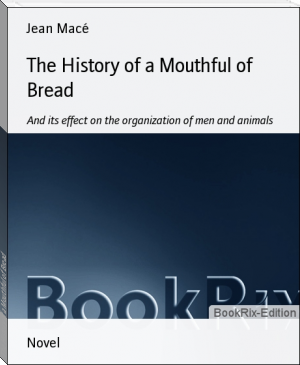The History of a Mouthful of Bread, Jean Macé [best autobiographies to read TXT] 📗

- Author: Jean Macé
Book online «The History of a Mouthful of Bread, Jean Macé [best autobiographies to read TXT] 📗». Author Jean Macé
on the submerged rocks of islands in warm seas, and the material which you know so well by the name of coral-the very coral of which the necklaces and bracelets in the jeweller's window are composed.
In all cases of compound zoophytes, however, there is one great point which they have in common with the worm, viz., that there is an association of distinct lives acting unanimously; or, rather, to the same end. Plainly as this is seen in the worm, it is still more obvious in the zoophyte. There is no need here either of cutting them up yourself or of taking other people's dissecting operations upon trust. It is enough to use your eyes, with the help, it is true, now and then, of the microscope's clearer sight.
You know the old oak-tree which stands on the outskirts of the wood, and is called among the country folk the patriarch ? Now, this is clearly not an individual, but a nation. It is not a tree; it is a forest. Nay, may I not call it a green field? For this trunk, so truly venerable from ages of growth that one feels inclined to bow to it as one goes by, is, in fact, a collection of structures, accumulated by countless generations of fleeting herbs, i.e., leaves, not one of which has lived for the space of a whole year round. Every spring some thousands and thousands of buds open to the sun; each one, therefore, affording a passage to a little green point; and this point is an oak, who comes into the world, like the first oak, the grandfather who formerly came forth from an acorn, under the form of an herb or tender leaf, which a sheep might have browsed upon. Yet it is so thoroughly an oak, that you have only to take out the bud carefully before it has expanded and fasten it into another one's place upon a tree of the same family, though of a different species, and it will produce an oak of the same sort as its old companions, and which will, as it progresses, look quite a stranger among the indigenous branches. This is the secret of what the gardeners call grafting , and I advise you to try the operation upon rose-trees, for nothing is more amusing. When the autumnal frosts set in, all these troops of new little oaks die, and deliver up their leaves to the wind; but they leave behind, as their summer's work, a tiny morsel of new wood, upon which, if you look carefully, you will see a fresh bud dawning-the hope of the coming season. And thus the great life of the tree is perpetuated from century to century by an uninterrupted succession of transient lives, reminding one in all respects of the life of a nation; and the similitude is complete in the evergreen trees, where the new leaf makes its appearance before the old one has quitted the stem.
And such is the life of the great stone trees and shrubs of various kinds which grow under tropical seas, and whose makers and inhabitants are the coral polyps, the undoubted heads of the Zoophyte race.
But before considering the polypidom, or external dwelling (otherwise called the coeneciun, or "common house"), you must learn something of its originator, the little polyp, who lives inside, and belongs to a family so widely spread over the face of the earth, that there are scarcely any waters, whether salt or fresh, without them.
In your own neighborhood, if you know how to look for them, are to be found on the banks of ponds, or along the borders of streams which lie sleeping in roadside ditches, extraordinary beings which, a hundred years and more ago, completely bewildered the good Dutch naturalist Trembley, who had taken it into his head to study them. Picture to yourself some very tiny bags made of a kind of jelly; gray, brown, or, most commonly of all, green in color, always transparent, and fastened by their base to the stalks of carex, water-lentils, or the confervas, which grow in still water. A hunter on the watch, this bag shoots out on all sides a number of slender threads, like so many whip-lashes, arranged within a circle round the edge of its opening or mouth; and with these whip-lashes all the animalcules which come within reach are entwined, stifled, and carried away to the ever-yawning little gulf, where they are digested in less than no time. Whatever will not digest comes out afterwards by the way it went in. Of what becomes of the results of this digestion it is impossible to form an idea. Were you to cut up the bag and put little morsels of it under the best microscope possible, you would see positively nothing but solid jelly, without the least sign of any organisation whatever. But this is not all. Replace these morsels in the water, and come back tolook at them at the end of five, twenty, or thirty hours. Each one of them will have become a perfect bag, ready to multiply itself afresh if you submit it to the same operation. Sometimes, on some part of the original bag, there suddenly appears a little raised spot, like that which came on your baby brother's arm the other day after he had been vaccinated. What would you have said, if this ugly spot had grown larger and larger without stopping; if it had assumed legs, arms, and a head, and so become another baby, growing from the arm of the first one? Yet this is just what the spots do which come on the bag I have been telling you of; and people have come across bags of a larger species still-between one and two inches in size, in fact-which in this way carried twelve young ones on their backs, if one is allowed to talk of stomachs having backs . You perceive at once that this commencement of animal life is not even a digestive tube, and that nothing in it can he found but a stomach, opening straight to the air above and closed up below.
It was Réaumur, the originator of the famous thermometer, who gave a name to the wonderful bags discovered by Trembley. Aristotle had previously bestowed the title of polypus (many feet) upon a mollusk outwardly formed upon a similar model [Footnote: This is the cuttle-fish, called polypus by old naturalists. We shall speak of it fully hereafter in the history of the movement machine.] with large whips disposed regularly in a circle round the mouth, and intended for a similar use, only that they have another function besides; that of carrying the body along in the capacity of feet by clinging on to the rocks with their suckers as they go. Réaumur transferred this name to the newcomers, and called them fresh-water polyps, to the infinite amusement of Voltaire, who had declared that they were only blades of grass; a new proof, among many others, that in natural history all the intellect in the world is not worth a pair of good eyes.
But it was soon found out that, in collecting these bits of living jelly near the Hague, Trembley had laid his hands on little beings of immense importance on the surface of the globe, and that he had discovered under his microscope the explanation of a mystery which had spread itself, setting human science at defiance, over some thousands of square miles.
I talked to you just now of the jeweller's coral, of which ornaments so becoming to dark-haired people are made. That is one of the stony polypidoms I spoke of as stone trees found at the bottom of the sea, where it grows attached to the rocks in the form of a charming little shrub, stretching its red branches in all directions. The Greeks, who were never at a loss, relate that Perseus one day laid down upon the sea-shore the famous head of Medusa, the sight of which had the property of turning everything to stone, and that the nymphs, in sport, showed it to the coral shrubs; a fact which explained everything quite naturally. Without exactly holding this mythological explanation, modern philosophers had not got much farther, and coral was still a puzzle to them, which they were not fond of troubling themselves about; till, roused by Trembley's revelations, they examined it more carefully, and discovered in its soft extremities (hitherto unnoticed) those same living jelly-bags or sacs, with their circlets of legs, or rather arms, charged with supplying them with food. These were marine polyps, which grow, like those in fresh water, one upon another, but each in its own crusty cell; and like the buds of the oak, these buds of the stony tree form each its special deposit, which it bequeaths in dying to the general mass. In short, as the tender shoot of the oak is filled by degrees with the wood which forms within it, and hardens into a branch, that goes on increasing by perpetually new growths, so the jelly polyp of the polypidom hardens below into stone and dies incessantly at the base, while it lives on indefinitely above in its constantly-renewed summit.
Do not get tired of all this phantasmagoria, my dear pupil: it is a matter of the highest interest. Here is the point of junction-the bond, as it were, between the three kingdoms: an animal growing vegetable-wise produces a mineral mass, extracted from the waters of the sea by an infinity of little living crucibles, who carry on under our eyes the work begun in the first ages of the globe, and quietly manufacture continents for the use of future generations. This ought to console you, my dear child, for being little. It is by little things that God loves to effect what is truly great. He did not seek out the elephant or the whale to form these worlds; He chose workmen no bigger than a pin's head. I have spoken to you about jeweller's coral, which is made into toys or presents for ladies to adorn themselves with; but its brethren, the madrepores of the Pacific Ocean play a very different part. They have formed in front of the shores of New Holland a barrier of reefs three hundred leagues in extent and twenty wide. What are all our buildings after this?-those pyramids and cathedrals which seem so gigantic to us? This ever-increasing wave of coral polypidoms will one day shut against navigators the entrance to one part of the sea's tropical region; and lands not to be found on the map to-day will then lie stretched out under the sun, covered with plants and animals; and this in places where ships now plough the ocean. Know, also, that a great portion of the soil which we tread under foot has no other origin. It was manufactured formerly in the sea by infinite myriads of beings, often infinitely small. Each one, whether polype or shell, produced its grain of stone, and from all these grains God, who directed their work, has made our country.
But it is time to bring this chattering to a close, for it will never end if I do not force myself to stop. I leave it with regret; but all these paths through which I have threaded my way one after another without counting them, have already made a volume which may possibly be considered too large for you. There are many other zoophytes besides the coral polypes, and all of them beautiful and curious. They all inhabit the fertile depths of the waters where God has deposited the first germs of life. I cannot describe them to you now. But to make amends, I
In all cases of compound zoophytes, however, there is one great point which they have in common with the worm, viz., that there is an association of distinct lives acting unanimously; or, rather, to the same end. Plainly as this is seen in the worm, it is still more obvious in the zoophyte. There is no need here either of cutting them up yourself or of taking other people's dissecting operations upon trust. It is enough to use your eyes, with the help, it is true, now and then, of the microscope's clearer sight.
You know the old oak-tree which stands on the outskirts of the wood, and is called among the country folk the patriarch ? Now, this is clearly not an individual, but a nation. It is not a tree; it is a forest. Nay, may I not call it a green field? For this trunk, so truly venerable from ages of growth that one feels inclined to bow to it as one goes by, is, in fact, a collection of structures, accumulated by countless generations of fleeting herbs, i.e., leaves, not one of which has lived for the space of a whole year round. Every spring some thousands and thousands of buds open to the sun; each one, therefore, affording a passage to a little green point; and this point is an oak, who comes into the world, like the first oak, the grandfather who formerly came forth from an acorn, under the form of an herb or tender leaf, which a sheep might have browsed upon. Yet it is so thoroughly an oak, that you have only to take out the bud carefully before it has expanded and fasten it into another one's place upon a tree of the same family, though of a different species, and it will produce an oak of the same sort as its old companions, and which will, as it progresses, look quite a stranger among the indigenous branches. This is the secret of what the gardeners call grafting , and I advise you to try the operation upon rose-trees, for nothing is more amusing. When the autumnal frosts set in, all these troops of new little oaks die, and deliver up their leaves to the wind; but they leave behind, as their summer's work, a tiny morsel of new wood, upon which, if you look carefully, you will see a fresh bud dawning-the hope of the coming season. And thus the great life of the tree is perpetuated from century to century by an uninterrupted succession of transient lives, reminding one in all respects of the life of a nation; and the similitude is complete in the evergreen trees, where the new leaf makes its appearance before the old one has quitted the stem.
And such is the life of the great stone trees and shrubs of various kinds which grow under tropical seas, and whose makers and inhabitants are the coral polyps, the undoubted heads of the Zoophyte race.
But before considering the polypidom, or external dwelling (otherwise called the coeneciun, or "common house"), you must learn something of its originator, the little polyp, who lives inside, and belongs to a family so widely spread over the face of the earth, that there are scarcely any waters, whether salt or fresh, without them.
In your own neighborhood, if you know how to look for them, are to be found on the banks of ponds, or along the borders of streams which lie sleeping in roadside ditches, extraordinary beings which, a hundred years and more ago, completely bewildered the good Dutch naturalist Trembley, who had taken it into his head to study them. Picture to yourself some very tiny bags made of a kind of jelly; gray, brown, or, most commonly of all, green in color, always transparent, and fastened by their base to the stalks of carex, water-lentils, or the confervas, which grow in still water. A hunter on the watch, this bag shoots out on all sides a number of slender threads, like so many whip-lashes, arranged within a circle round the edge of its opening or mouth; and with these whip-lashes all the animalcules which come within reach are entwined, stifled, and carried away to the ever-yawning little gulf, where they are digested in less than no time. Whatever will not digest comes out afterwards by the way it went in. Of what becomes of the results of this digestion it is impossible to form an idea. Were you to cut up the bag and put little morsels of it under the best microscope possible, you would see positively nothing but solid jelly, without the least sign of any organisation whatever. But this is not all. Replace these morsels in the water, and come back tolook at them at the end of five, twenty, or thirty hours. Each one of them will have become a perfect bag, ready to multiply itself afresh if you submit it to the same operation. Sometimes, on some part of the original bag, there suddenly appears a little raised spot, like that which came on your baby brother's arm the other day after he had been vaccinated. What would you have said, if this ugly spot had grown larger and larger without stopping; if it had assumed legs, arms, and a head, and so become another baby, growing from the arm of the first one? Yet this is just what the spots do which come on the bag I have been telling you of; and people have come across bags of a larger species still-between one and two inches in size, in fact-which in this way carried twelve young ones on their backs, if one is allowed to talk of stomachs having backs . You perceive at once that this commencement of animal life is not even a digestive tube, and that nothing in it can he found but a stomach, opening straight to the air above and closed up below.
It was Réaumur, the originator of the famous thermometer, who gave a name to the wonderful bags discovered by Trembley. Aristotle had previously bestowed the title of polypus (many feet) upon a mollusk outwardly formed upon a similar model [Footnote: This is the cuttle-fish, called polypus by old naturalists. We shall speak of it fully hereafter in the history of the movement machine.] with large whips disposed regularly in a circle round the mouth, and intended for a similar use, only that they have another function besides; that of carrying the body along in the capacity of feet by clinging on to the rocks with their suckers as they go. Réaumur transferred this name to the newcomers, and called them fresh-water polyps, to the infinite amusement of Voltaire, who had declared that they were only blades of grass; a new proof, among many others, that in natural history all the intellect in the world is not worth a pair of good eyes.
But it was soon found out that, in collecting these bits of living jelly near the Hague, Trembley had laid his hands on little beings of immense importance on the surface of the globe, and that he had discovered under his microscope the explanation of a mystery which had spread itself, setting human science at defiance, over some thousands of square miles.
I talked to you just now of the jeweller's coral, of which ornaments so becoming to dark-haired people are made. That is one of the stony polypidoms I spoke of as stone trees found at the bottom of the sea, where it grows attached to the rocks in the form of a charming little shrub, stretching its red branches in all directions. The Greeks, who were never at a loss, relate that Perseus one day laid down upon the sea-shore the famous head of Medusa, the sight of which had the property of turning everything to stone, and that the nymphs, in sport, showed it to the coral shrubs; a fact which explained everything quite naturally. Without exactly holding this mythological explanation, modern philosophers had not got much farther, and coral was still a puzzle to them, which they were not fond of troubling themselves about; till, roused by Trembley's revelations, they examined it more carefully, and discovered in its soft extremities (hitherto unnoticed) those same living jelly-bags or sacs, with their circlets of legs, or rather arms, charged with supplying them with food. These were marine polyps, which grow, like those in fresh water, one upon another, but each in its own crusty cell; and like the buds of the oak, these buds of the stony tree form each its special deposit, which it bequeaths in dying to the general mass. In short, as the tender shoot of the oak is filled by degrees with the wood which forms within it, and hardens into a branch, that goes on increasing by perpetually new growths, so the jelly polyp of the polypidom hardens below into stone and dies incessantly at the base, while it lives on indefinitely above in its constantly-renewed summit.
Do not get tired of all this phantasmagoria, my dear pupil: it is a matter of the highest interest. Here is the point of junction-the bond, as it were, between the three kingdoms: an animal growing vegetable-wise produces a mineral mass, extracted from the waters of the sea by an infinity of little living crucibles, who carry on under our eyes the work begun in the first ages of the globe, and quietly manufacture continents for the use of future generations. This ought to console you, my dear child, for being little. It is by little things that God loves to effect what is truly great. He did not seek out the elephant or the whale to form these worlds; He chose workmen no bigger than a pin's head. I have spoken to you about jeweller's coral, which is made into toys or presents for ladies to adorn themselves with; but its brethren, the madrepores of the Pacific Ocean play a very different part. They have formed in front of the shores of New Holland a barrier of reefs three hundred leagues in extent and twenty wide. What are all our buildings after this?-those pyramids and cathedrals which seem so gigantic to us? This ever-increasing wave of coral polypidoms will one day shut against navigators the entrance to one part of the sea's tropical region; and lands not to be found on the map to-day will then lie stretched out under the sun, covered with plants and animals; and this in places where ships now plough the ocean. Know, also, that a great portion of the soil which we tread under foot has no other origin. It was manufactured formerly in the sea by infinite myriads of beings, often infinitely small. Each one, whether polype or shell, produced its grain of stone, and from all these grains God, who directed their work, has made our country.
But it is time to bring this chattering to a close, for it will never end if I do not force myself to stop. I leave it with regret; but all these paths through which I have threaded my way one after another without counting them, have already made a volume which may possibly be considered too large for you. There are many other zoophytes besides the coral polypes, and all of them beautiful and curious. They all inhabit the fertile depths of the waters where God has deposited the first germs of life. I cannot describe them to you now. But to make amends, I
Free e-book «The History of a Mouthful of Bread, Jean Macé [best autobiographies to read TXT] 📗» - read online now
Similar e-books:





Comments (0)